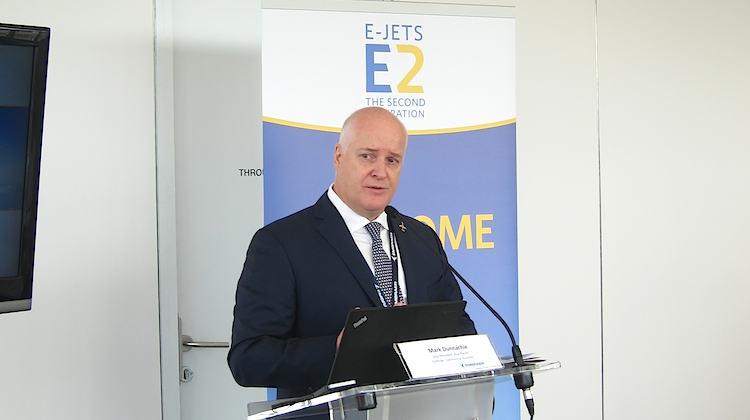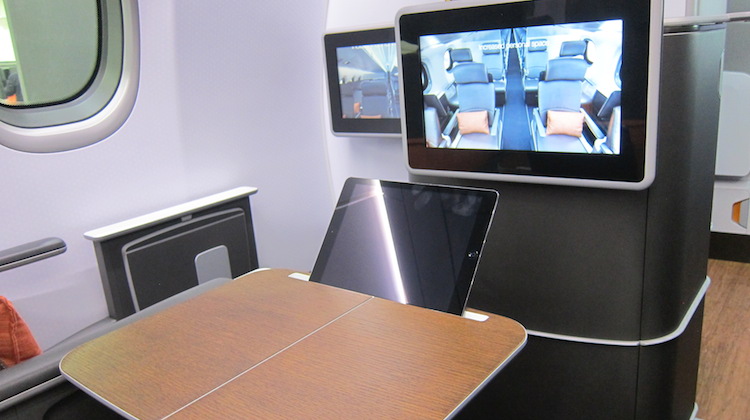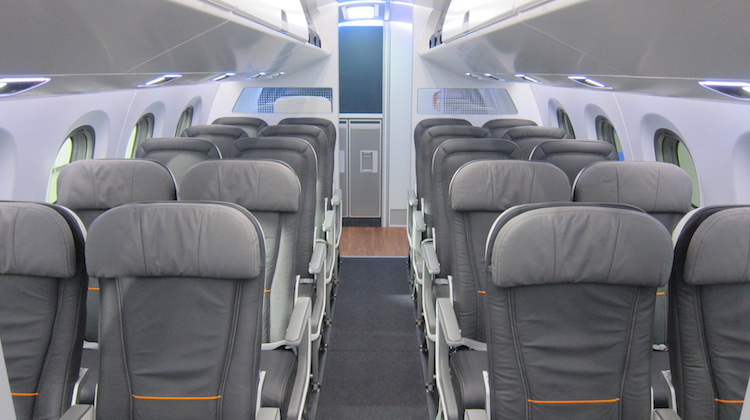
Embraer expects airlines in Australia and New Zealand will require up to 50 jet aircraft in the 70- to 130-seat market over the next decade as it touts the suitability of its new generation E2 jets for the local market.
The Brazil-based manufacturer recently brought a mockup of its E2 jets to Sydney as part of an Asia-Pacific demonstration tour, where it was on display for journalists, industry players and potential customers.
There are currently four Embraer jet operators in Australia – Virgin Australia with 18 E190s, Air North (four E170s), Cobham (one E190) and Jetgo (three ERJ-135 regional jets).
Embraer vice president of Asia-Pacfic Mark Dunnachie says the next generation E2 family of aircraft currently under development would complement existing narrowbodies from Boeing and Airbus.
“We are not going out to replace A320s, 737s, but we believe there is a real complement to that larger narrowbody where it is smart to fly the right number of seats so you get the cream,” Dunnachie told reporters in Sydney.
The E2 jet was launched at the Paris Airshow in 2013 and features three models – the E175-E2 which seats 80-90 passengers, the E190-E2 (97-114 seats) and the E195-E2 (120-144 seats).
Embraer has forecast entry into service for the E190-E2 to occur in the first half of 2018, with the E195-E2 to follow in 2019 and E175-E2 due a year later.
The E2 family of jets has secured 210 firm orders and 380 commitments since launch, Embraer says.



The aircraft will be powered by Pratt and Whitney PW1700G and PW1900G geared turbofan engines.
Pratt & Whitney director of marketing for commercial engines Jim Speich said these latest generation engines had much smaller noise footprints compared with current powerplants.
“This is really about curfews,” Speich said.
“If you can come in quieter, convince your authorities that you are quieter maybe you can open up the curfews, get another flight in a day which would be a significant economic benefit.”
Speich said the quieter engines could also lower noise fees and result in more direct flight tracks into and out of airports, reducing fuel consumption.
In addition to the E2, the Pratt and Whitney geared turbofan engine will also be featured on Airbus A320neo, Mitsubishi Regional Jet, Bombardier CSeries and Irkut MC-21 programs.
“This engine will be fully mature when it enters service with the E2,” Speich said.
Embraer has forecast demand for 1,540 jet aircraft in the 70 to 130 seat category in the Asia-Pacific region over the next 20 years.
Dunnachie said he expected a “base requirement of say 30-40 units, with a stretch to 50 say over the next seven-year window” in Australia and New Zealand.
He noted both Virgin, as Embraer’s largest operator in the region, and Qantas with its substantial regional fleet, had a significant number of aircraft in the 70-130 seat category that would be ready for replacement in the period ahead.
“We would of course welcome the opportunity to push the very clear advantages of the E2 as a rollover when you see the cost benefit,” Dunnachie said.
“And in the new cabin I think the staggered business class seat I think is a real winner. I think that’s something that will really differentiate you in the market.
“Qantas would be of course someone we would wish to try and lobby to look at our product and that’s exactly what we are doing.
“Just to clarify, we have no formal campaign, we are not in any discussions but clearly the applicability of both the E1 and the E2 in the context of Qantas’s regional fleet could also be an interesting product that we would hope they would certainly look at.”
Read more about Embraer’s E2 jets in the March edition of Australian Aviation magazine.
















Bob
says:While the thinking of Embraer might be correct, convincing the authorities in regards to curfew because of lower noise prints is not realistic. If curfew or similar issues will be addressed, changes in the airport master plan is where it becomes difficult. It is not the technology of an aircraft that opens opportunities but getting the political hurdle out of the way. Meaning, the public will have a say and there will be a lot of red tape to be mastered. If we would not have to deal with the master plan and major development plan difficulties, we would have more secondary airports open for RPT traffic and everyone would be a winner. One will be surprised how difficult and expensive it is to deal with any changes at airports. The public wants all the benefits from air travel yet many are opposed to any changes that airports want to make, such as aviation related developments. Yet, shopping centres on airport land is always no issue….
marc
says:2 x 2 seating layout is always a hit.
Mac Carter
says:The E Jet E2 series should make an attractive replacement for the DC 9 based Boeing product as well as the current crop of F100/F70 as they approach the end of their operating lives.
from a passenger perspective, I would prefer to travel in a E Jet compared to the current B737.